Nothing says heavy metal quite like a V guitar. Used by the absolute best rock and metal players such as Randy Rhoads, Dave Mustaine, Robert Flynn, and Alexi Laiho. The V shape lets you know exactly what you’re in for well before a single note has even been played.
This makes them a popular choice for younger musicians who are looking to make a bold statement, and the good news is there’s no shortage of budget-friendly V-shape guitars available.
Top 3 - V Style Guitars
So whether you’re an advanced player who’s always wanted to own a V guitar but doesn’t want to break the bank, or a parent looking to get your child a new guitar this Christmas, there’s something available for you.
So today I’ve put together a hand-picked list of some of the very best affordable V-style guitars (but no unbranded clones) that not only look amazing, but they sound great and are reliable too!
6 Best Budget V Style Guitars that You Can Afford
1. Jackson JS Series RR Minion JS1X
If you’re a Randy Rhoads fan, this is going to be the perfect choice for you. Randy’s original Jacksons were distinguished from other models like the Gibson V by being more pointy and having a shortened bottom horn that tapers off which makes it look extra sleek and sharp.
Tragically, Randy Rhoads didn’t get to play these much. He left this mortal plane not long after the designs were finalized.
However, shred-ready players looking to capture some of the unique attitude and flash of the late, great Ozzy axeman’s playing need look no further.
This guitar is designed to be an affordable, entry-level guitar that is specifically geared toward those who want to shred and play heavy metal music.
The most important feature of the Jackson JS Series RR Minion JS1X is its shorter scale length. Coming in at just 22.5” (as opposed to a regular scale length of 25.5”) the neck is perfectly suited to younger players or those who have smaller hands/fingers.

Jackson JS Series RR Minion JS1X
For larger-proportioned players, like me, it makes even the most athletic of finger stretches and runs feel like a breeze.
Despite being a cheaper guitar, there are a few aspects of the RR Minion that you wouldn’t commonly associate with a budget instrument.
Most importantly is the graphite reinforcement in the neck which helps protect it against temperature and humidity changes. This means it will require far less maintenance and upkeep than a regular guitar, ideal for a beginner who doesn’t know how to set a guitar up by themselves yet.
The guitar includes two of Jackson's own high-output humbucking pickups which are specifically voiced for metal, although they aren’t super-articulate, they get the job done.
I’d swap these out for Seymour Duncans or another similar high-gain-ready pickup pretty quickly if you want to sound like Randy Rhoads. The stock Jackson pickups aren’t at all my cup of tea: they get unpleasantly mushy and muddy at higher gain levels.
If you’re playing this guitar, you’re most likely playing at higher gain levels. It’s worth the expense of upgrading the pickups here.
One thing I found troublesome about the guitar was the volume knob being mounted so close to the low E string which caused my hand to keep knocking into it. If you’re a player with smaller hands this won’t be an issue.
Read more: our full take on the JS1X
2. Epiphone Flying V
The Epiphone Flying V adopts that iconic Gibson V look which was inspired by the original classic from 1958. It includes the thicker and more rounded horns which harken back to the original guitars of artists such as Jimi Hendrix and Albert King.
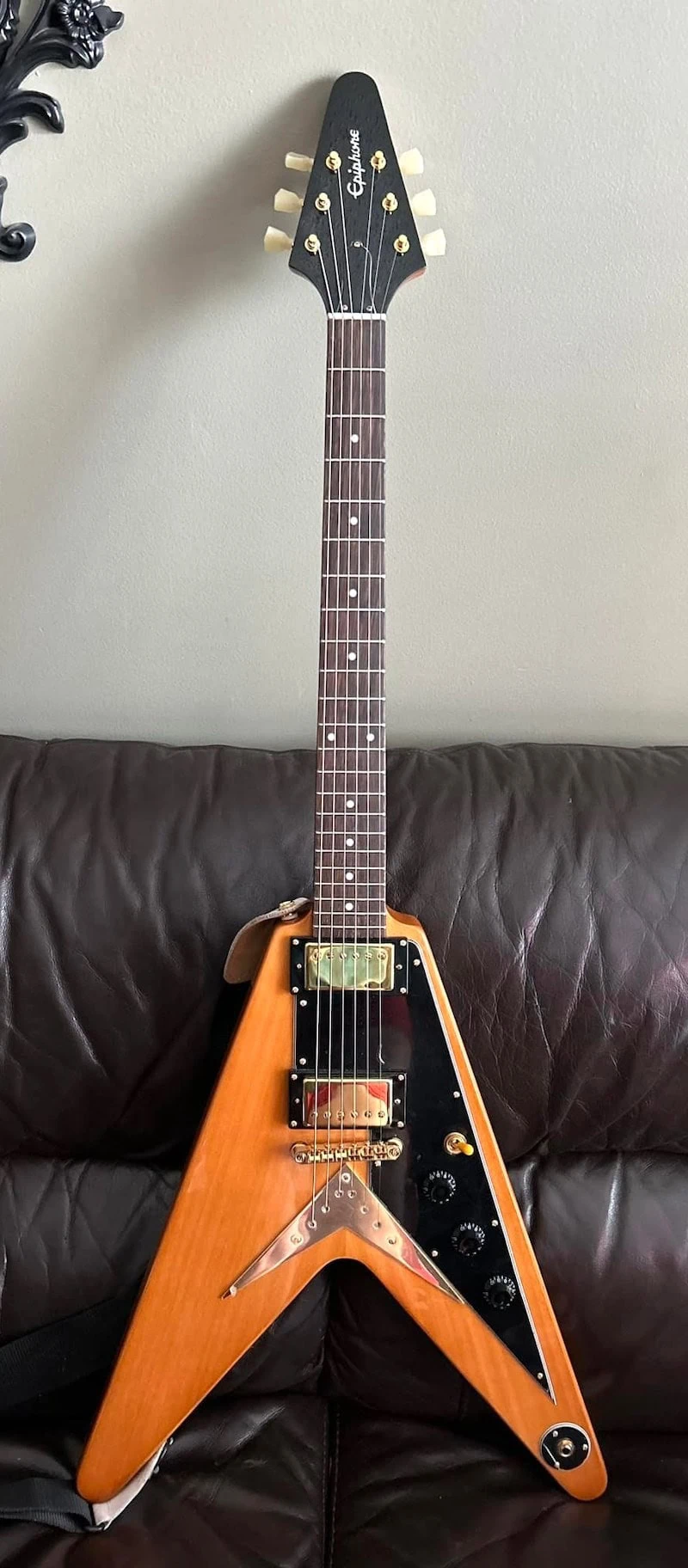
Epiphone Flying V
Until the likes of Jackson and Dean started copying and radicalizing the V shape, the softer-looking Gibson V was the only shape available.
This makes it more of an appropriate choice if you're a traditional blues/rock player. However, plenty of '80s metal legends played a Gibson-style V, including Metallica’s James Hetfield.
Epiphone is the smaller brother of Gibson guitars, they manufacture instruments that are essentially the same design as real Gibsons but use cheaper components or are made overseas to bring the cost down.
But don’t let that fool you, Epiphone guitars are fantastic and the difference between them and Gibson is not as substantial as you might think.
The Epiphone V has all the classic features that made the original Gibson V great, the slimmer C profile neck shape, the contoured neck joint for easy access to all 22 frets, and Epiphones own ProBucker 2/3 in the neck and bridge position respectively.
I find the neck profile of the Epiphone Flying V particularly comfortable. It reminds me a lot of the neck on a Gibson SG. It’s even easier to reach the extreme high notes at the upper end of the fretboard, however, thanks to the V-shaped body.
The neck on this guitar tends to move upwards, as the heavier body pulls downwards.
Tonally, I found the guitar hits all the main beats of the original Gibsons, with that nice pronounced midrange and fantastic sustain. Despite its bulky body when compared to some other V models, the shorter 24.75” scale length helps it remain a bit more playable for younger musicians with smaller hands.
Overall the Epiphone flying V offers a fantastic entry point into the world of the Gibson-style V, yet despite its lower price tag this instrument could easily be used in any professional musical setting and makes a strong choice if you wanted a less metal-looking V guitar.
As with most Epiphone guitars, the stock pickups in this V are too muddy and inarticulate for my taste. I’d recommend switching them out for something hotter if you can.
3. Jackson JS Series King V JS32
While at first glance the King V may look very similar to the Randy Rhoads V, you can easily tell it apart as the bottom horn of the V is the same length as the top. This makes it more substantial in size and weight, but its bulkier design makes it a pain to play sitting down.
The King V is much pointier and more aggressive-looking than the Gibson-style V. This is clearly a shred machine built to rock.

Jackson JS Series King V JS32
Once again this is designed to be a rock and metal machine and this time it includes a full tremolo system perfect for divebombs and wailing squeals.
One of the best features of the King V JS32 is the compound radius fretboard which starts off at 12” near the nut for comfortable chord holding, and it slowly tapers up to a flatter 16” radius towards the bridge to help facilitate super-fast lead soloing. A wonderful addition that’s seldom seen on guitars at this price point.
I was able to play at lightning speeds for minutes on end without experiencing any fatigue in my left hand, likely thanks to the special fretboard.
The guitar has Jackson's own unbranded humbuckers which, while certainly high output, did come off as exceptionally muddy and unarticulate. I highly recommend putting in some aftermarket pickups which will help enhance the sound greatly.
Fortunately, the pickups are mounted via pickup rings instead of direct mounted so this should be an easy process, even if you’re not experienced in swapping out pickups.
Its sleek, black aesthetic which includes all-black hardware, coupled with those iconic Jackson sharktooth inlays makes this thing look efficient and dangerous. A great choice for anyone who wants to show they mean business from the get-go.
4. Epiphone Kirk Hammett V
For aspiring shredders looking to emulate the tones of their heroes, there aren’t many better brands than Epiphone.
While most professional players balk at the prospect of playing a signature model, I think they can be a great investment for anyone looking to capture a specific tone.
If you’re anything like me, you started looking at Flying V-style guitars because Metallica looked so cool with them.
Fortunately, Epiphone released an affordable guitar that effectively offers classic Metallica vibes in the Kirk Hammett V.
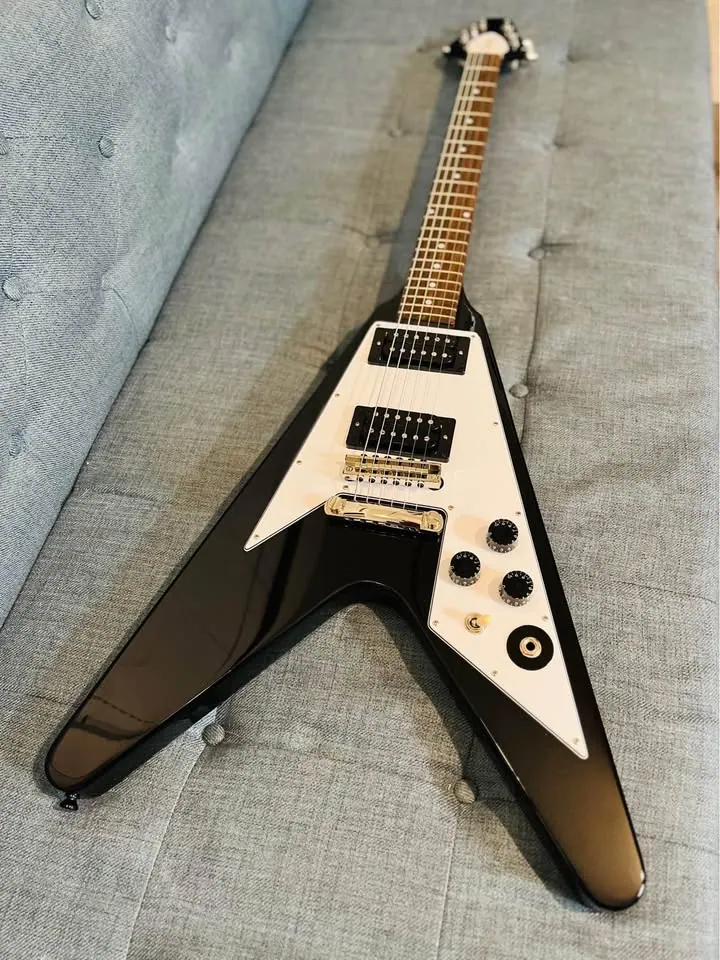
Epiphone Kirk Hammett 1979 Flying V
The guitar’s mahogany body and neck offer classic mid-forward Gibson tone. The high-output Gibson pickups far outstrip any stock Epiphone pickups for tone and articulation.
Kirk Hammett himself switched the stock Gibson pickups for EMGs at some point in the '80s, but these will do more than enough to handle the white-hot tones from Kill ‘Em All, Ride the Lightning, and Master of Puppets.
When I plugged this guitar in, I launched into the riff from “For Whom The Bell Tolls” and enjoyed every moment playing the song from beginning to end.
Even if you’re not a huge Metallica fan, this V is designed to emulate the classic late-70s Flying V.
5. ESP LTD Arrow-200
ESP are no strangers to flying V designs, particularly having made Rhoads style V’s for the legendary Alexi Laiho. But here we have an alternative V model which shakes up a few design elements to provide something a little more unique and quirky than your regular V.

ESP LTD Arrow-200
The first thing to note is the extreme cutaway on the underside of the guitar, not only does this create a cool asymmetric look but it gives unhindered access to frets 21-24 and is supremely comfortable to play.
The inner side of the V shape has also had some additional contouring which allows your leg to fit snugly inside, which makes it far better suited to playing sitting down it also keeps the cables from jabbing into your leg which can be a problem on some V-style guitars.
The ESP LTD Arrow-200 includes two of ESP’s own LH-301 humbucking pickups which were specifically voiced for rock and metal tones. But it has an extra trick up its sleeve as it can also be coil split, allowing for some really smooth clean tones.
The coil splitting doesn’t exactly turn this metal machine into a twanging Telecaster. It really just thins out the Arrow’s existing tone. It’s a neat feature, but not one that I’d use in most live settings.
The Floyd Rose tremolo offers access to all the Dime squeals your heart could desire.
However, one thing to note is there’s no tone knob here, just a single volume knob and a 3-way toggle switch. I appreciate this bare-bones approach. When was the last time you saw a serious metal shredder messing around with their tone knob anyway?
6. Kramer Nite-V
One downside to the regular Gibson V and Jackson V shapes is the fact that they are popular, you’ll see these shapes everywhere which can be a real downer if you’re looking for something truly unique that’s going to make you stand out from the crowd.
This is where you might want to consider the Kramer Nite-V which has its own unique take on the traditional V shape with a more rounded middle section, which oddly enough feels great to play sitting down as your leg isn’t squished inside the tight angle of the V.
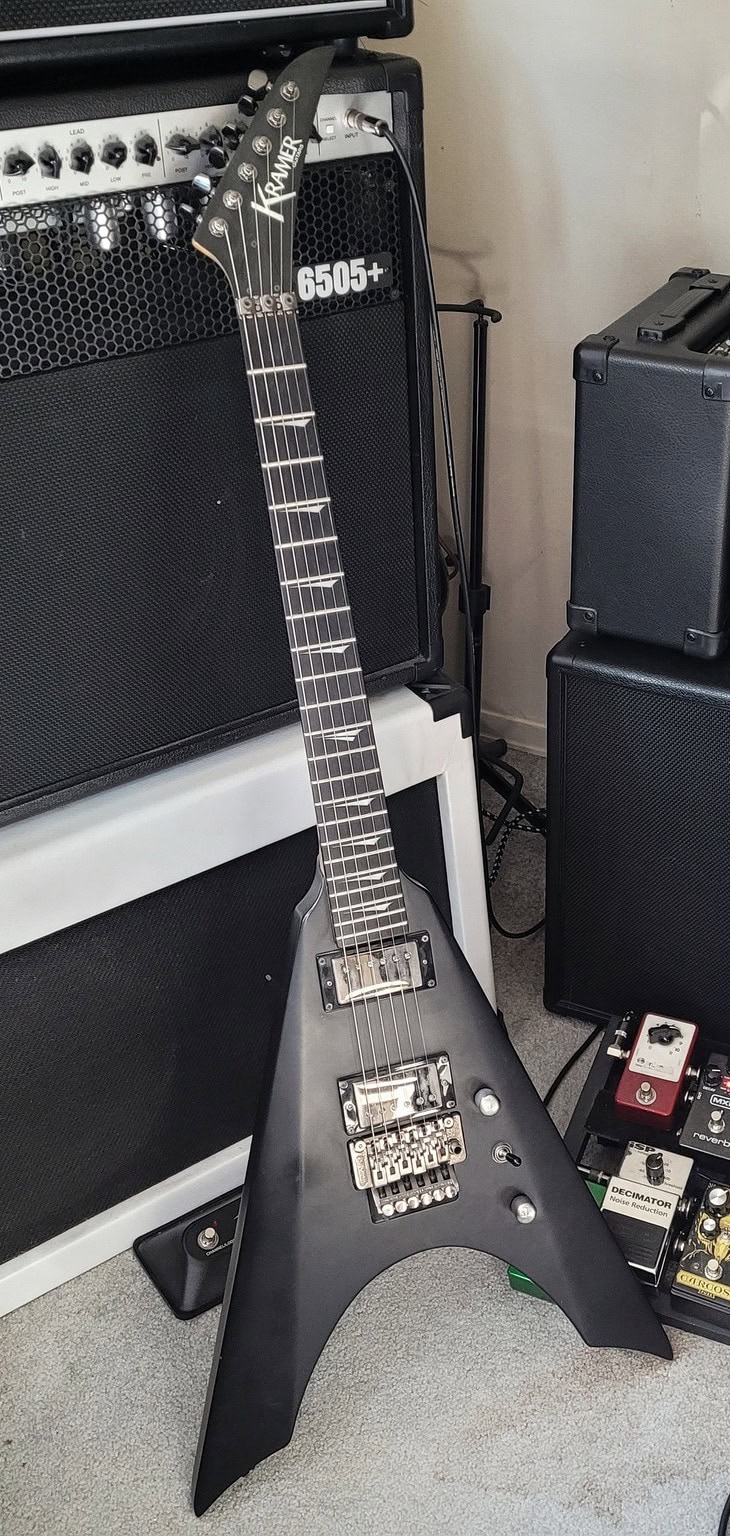
Kramer Nite-V
Kramer guitars are best known as '80s hair-band shred machines. The Baretta, for example, was a staple of MTV metal videos. The original Baretta was specifically aimed at the legions of Van Halen-inspired guitar players populating the airwaves in the early '80s.
Kramer, like Epiphone, is owned by Gibson, but unlike Epiphone doesn’t make Gibson-inspired instruments.
The Kramer V comes with high-output Kramer USA Eruption R and T humbuckers which sounded fantastic straight out of the box, no aftermarket upgrades are needed here! The twin Eruption humbuckers handle higher levels of gain extremely well, and clean up nicely with a roll of the V’s volume knob.
I plugged this guitar in and was immediately thrilled by its roaring tone through my Marshall amp. Power chords sound mean and authoritative. Van Halen-style riffs and licks sound appropriately incendiary. Palm mutes are nice and chunky, and there’s enough sustain for soaring bends and searing leads.
The string-through-body bridge is an interesting feature. Supposedly it improves sustain and intonation. I did have to adjust my technique after a lifetime of playing the usual Gibson-style bridge and tailpiece, but I’m sure I’d get used to it eventually.
I really liked the pearloid V shape inlays (which Kramer calls 'thorn inlays') which look extremely sleek when paired with the silver finish. Even the black pickup mounting rings were a great choice considering the overall solid-color aesthetic of the guitar. So you probably won't feel the urge to swap these out to create a more cohesive look.
If you’re looking for something that’s a little more unique and ‘out there’ when compared to what people generally envision when they think of a V guitar, this is certainly one to consider.
Choosing the Right V-Style Guitar for You
Despite their stylized look, the V is actually a really popular guitar shape, and not just for metal either, plenty of blues and rock players sport these extreme-looking instruments too.
But there are a lot of them on the market, and sometimes the subtle differences between their models might not be immediately clear, so here are a few tips and ideas you may wish to consider to ensure you’re picking the right V guitar for you.
Body Shape
When referring to a ‘V’ guitar, all this means is that the body generally takes on a V shape. But there are various takes on the V style that can be more or less appropriate for a particular player depending on their preference.
For example, the Gibson/Epiphone V shape features softer angles and more curvature. You could feasibly play one as a blues guitarist, like Albert King, or a metal shredder, like Kirk Hammett.
But they are also pretty huge, and monstrously heavy if it has a mahogany body. So if you’re small you may have trouble handling its overall large size.
In this scenario, you may wish to consider a Rhoads style V which has a reduced bottom horn that makes the guitar lighter, easier to manage for smaller players, and is also a little more comfortable to play while sitting down.
Output Jack Location
This is an often under-discussed point about V guitars, but it’s one that can easily catch you out if you aren’t careful.
The old Gibson V’s used to have the output jack on the front of the bottom horn, which is perfectly fine whether you play standing up or sitting down. However, as guitar designers tried to get smart they took to putting the jack on the side of the horn.
While this is great if you like to play standing and wish to tuck the cable around the strap (something people commonly do when performing live to stop the cables from accidentally getting yanked out should they step on it), when playing sitting down, it often means that jack will jab into the side of your leg.
Not only is this uncomfortable, but putting pressure on the cable causes the internal wires to weaken and eventually break. Basically, it ages your cables faster. To get around this, I use a right-angled jack on my guitar cable. Problem solved.
As a general rule, V guitars aren’t particularly comfortable to play sitting down. I tend to practice standing up anyway, but it’s worth considering.
Tonal Considerations
Even though these are budget guitars, we still want them to sound good. There are 2 main aspects of a guitar that you will want to take a look at to determine whether it’s going to produce the kind of sound you want, these are the pickups and the tonewoods.
Let’s start with the woods. In general, V guitars are used for heavier styles of music such as metal or hard rock. This means woods like mahogany or basswood are ideal as they will produce a rich and thick low end and provide all the punch you need to make your guitar sound massive.
Woods like swamp ash are less desirable as they tend to be a bit lacking in the bass and instead accent the highs.
When it comes to pickups, affordable guitars usually come with very cheap pickups that might not sound great out of the box. But don’t worry, it’s possible to remove these and upgrade them at a later date, so don’t let brandless pickups deter you from making a purchase, you don’t have to be stuck with them forever!
Some manufacturers choose to allocate their building budget to improved pickups, like the Kirk Hammett V or the Kramer Nite V. When looking at an affordable guitar, pickup quality is usually one of my foremost considerations.
Buy Expensive or Buy Cheap and Upgrade?
When it comes to buying a low to mid-range guitar, there are two philosophies people adopt that help to determine which price point is right for them.
The first approach is to just buy a slightly more expensive guitar that comes with nice pickups, woods, and tuners and essentially is good to go out of the box. This is ideal if you don’t like the idea of mucking around with the guitar and having to install upgrades at a later date.
The second approach which is worth considering if you are on an extreme budget, or you actually like the idea of tinkering and personalizing the guitar further down the line to make it your own, is to buy an ultra-cheap instrument which you then slowly upgrade over time.
There are a lot of aftermarket upgrades that can be made to a guitar, whether it be new pickups, giving it a fret dressing, new tuners, a graphite nut, or a brass trem block, almost everything can be upgraded on a guitar!
While ultimately your total investment will end up being comparable, having a guitar that you’ve worked on yourself and is unique to you can be very satisfying, but it does of course take a bit more manual work from you to install all these upgrades.
It’s a worthwhile endeavor, if only to learn more about how guitars work and fit together.
Shred on a Shoestring Budget
Despite their impressive looks, Flying V guitars don’t need to be expensive and you certainly don’t need to break the bank in order to look like a true guitar hero.
Provided you put some careful thought into your own needs and preferences you’ll easily be able to find a V-style guitar that fits both your budget and tonal requirements.
Best of luck with finding your next guitar purchase!
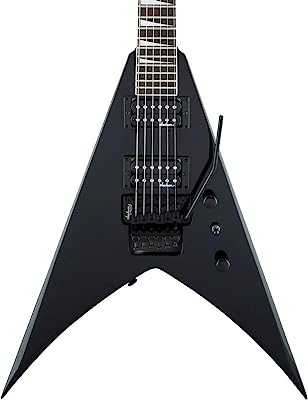
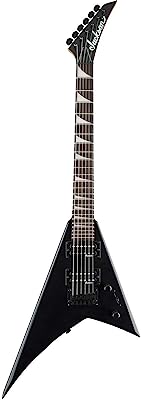

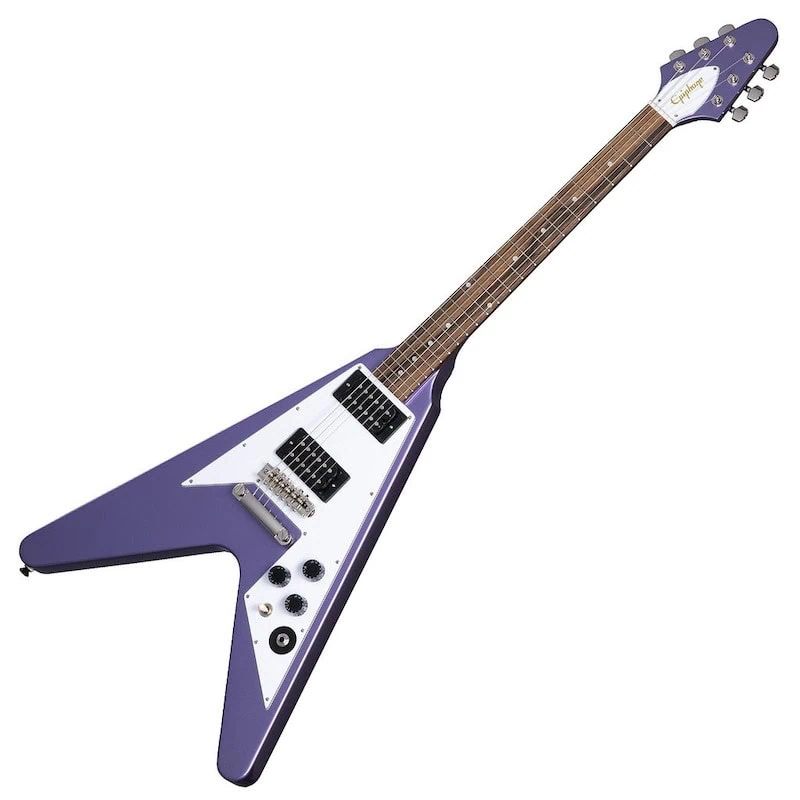


I have a Jackson Randy Rhoads V and a Jackson Kerry King V and they both sound about the same with the Jackson humbucking pickups, although, there’s a huge difference in the sitting down playability between these two guitars, the King V is very obstructive trying to play sitting down, while the Rhoads V anchors right to your leg, perfectly!!! So, if you’re a beginner or just need to practice a lot sitting down, my advice is getting the Jackson Randy Rhoads V, so you will have a comfortable sitting down practice routine!!!